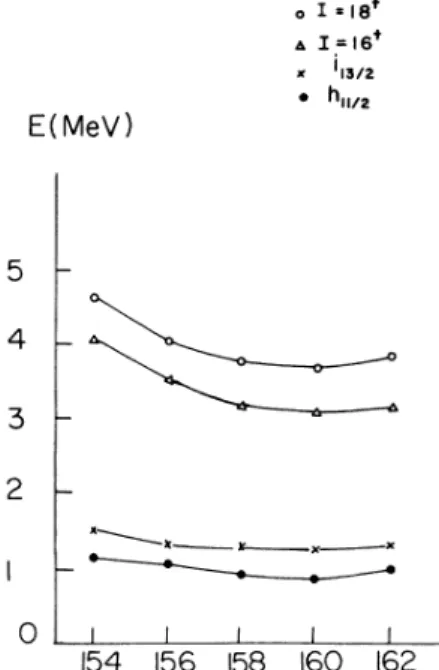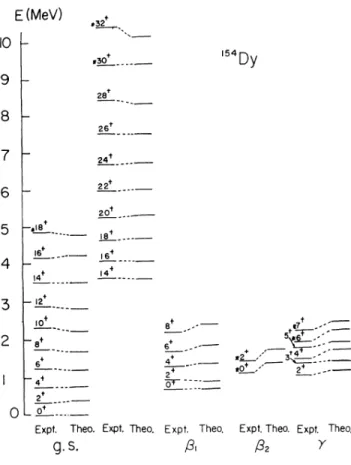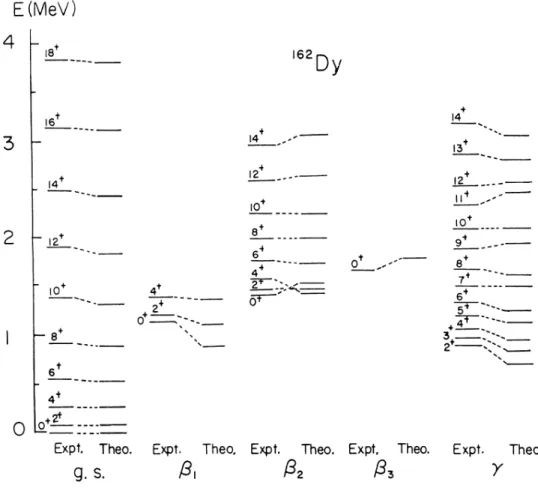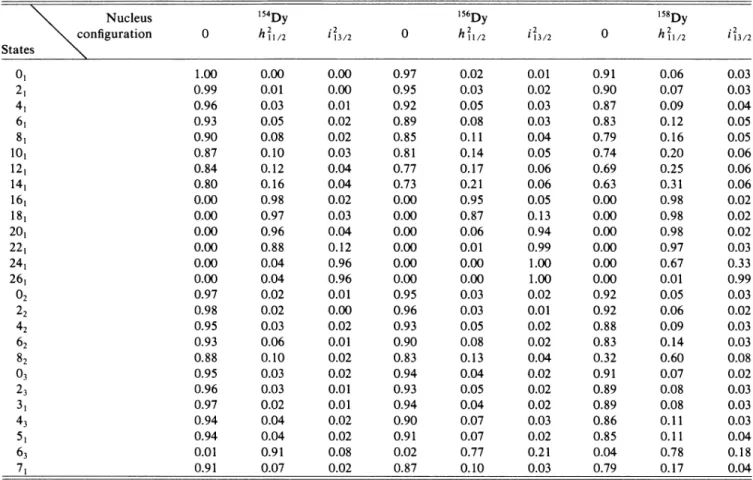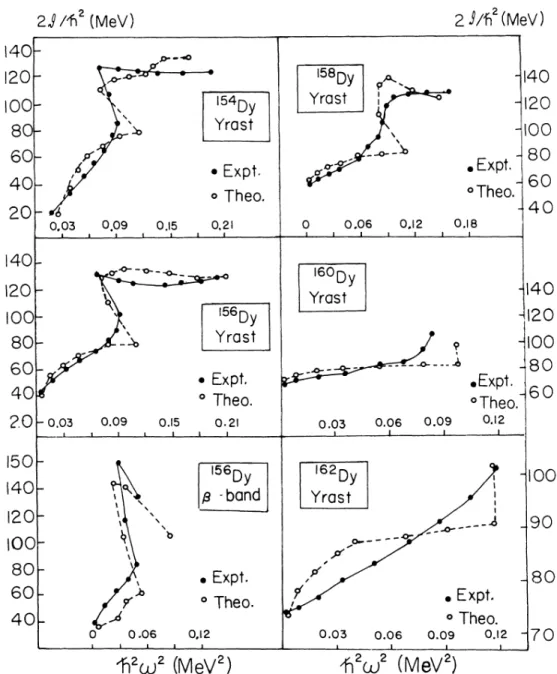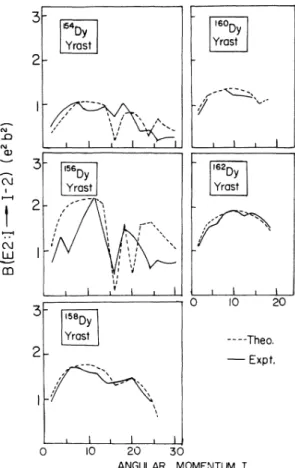Structure
of
even-even
Dy nuclei
in
the
interacting
boson
model with two-quasipartic$e
states
D.
S.
ChuuDepartment ofElectrophysics, National Chiao Tu-ng University, Hsinchu, Taiwan, Repubiic
of
ChinaS.
T.
HsiehDepartment ofPhysics, National Tsing Hua-University, Hsinchu, Taiwan, Republic ofChina
(Received 25January 1988)
Theenergy levels ofg.s.bands, Pbands, and y bands of
"
' Dy isotopes are studied in themod-elofthe traditional interacting boson approximation, allowing one boson tobreak and form a quasi-particle pair. The two quasiquasi-particles are allowed to excite to the ii3/p and h»&2 orbitals. Itwas
found that the energy levels ofthe g.s.,P,and y bands ofeven-even Dy nuclei can be reproduced
very well. The backbends ofthe moment ofinertia can also be reasonably described. The yrast
B
(E2)values are also calculated and compared with the experimental data.I.
INTRODUCTIONThe interacting boson approximation (IBA)model' has been remarkably successful ih the description
of
the low-lying collective states in many medium to heavy even-even nuclei. Recently, alarge amountof
high-spin statesof
nuclei has been accumulated. Among these data some backbending occurs as one plots the momentof
inertia versus the squareof
the angular velocity for the yrast bandof
a nucleus. Many efforts ' within the frame-workof IBA
have been attempted to understand the mechanismof
the sudden changeof
the momentof
iner-tia.
It
is believed that the backbending phenomenon is caused by the crossingof
the ground-state band and a two-quasiparticle band. ' Yoshida and co-workers 'ex-tended the n-p
IBA
(IBA-2) to allow oneof
the bosons tobe changed into apair
of
nucleons and applied this modelto study the Ge isotopes. Alonso et
al.
followed the workof
Yoshida and applied this model to reproduce the backbending phenomenaof
Dy isotopes. Since the num-berof
basic statesof
IBA-2 is tremendously large as the proton number goes away from the closed shell, one therefore needs to employ some kindof
truncation on the basic states. In order to make the problem manageable, Alonso etal.
used the weak-coupling technique in their calculation, although their calculation yieldedsatisfacto-ry results for the ground-state band, the abundant experi-mental data
of P
and y bands are still impossible tode-scribe. Recently, Harter et
al.
' investigated the rela-tionship between the IBA-1 and IBA-2 and concludedthat for
Ntr+Nv»
~Ntr Nv ~ theIBA-l
is—
avalid ap-proximation. This, in fact, has been reflected in the suc-cessof
the semimicroscopic modelof
Morrison etal.
"
in a boson basis based on the philosophyof
theIBF
mod-el.' Hence it should be valuable and interesting to study in more detail whether the structure
of
the whole energy spectrum including g.s.
,13,and y bands and the observedbackbending phenomena
of
the deformed nuclei can be described in termsof
allof
the whole basic statesof
theIBA-1
plus a two-quasiparticle pair. In this work we shall illustrate the model by taking Dy isotopes as atest-ing example.
In Sec.
II
we describe the model. InSec.
III
we present the results. The Anal section will give the summary and the discussion.II.
THEMODELThe Dy isotopes we are interested in have
Z
=66,
andN lies between 88 and
96.
Thus valence nucleons are in the 50—82 major shell. TakingZ
=50
and N=82
as thecore, the traditional
IBA
assumes the valence boson num-bers11,
12, 13,14, and 15for ' ' Dy isotopes.It
is as-sumed that one boson could break toform a quasiparticle pair, usually assignedto
a unique parity intruder orbital with spinj.
In the regionof
well-deformed nuclei the unique parity intruder orbitals such as h»&2 andi,
3/2 arethe most important because both the Coriolis antipairing effect and the rotation alignment effect increase with in-creasing angular momentum. In our model the two quasiparticles are allowed to excite to these two orbits. The angular momentum
of
the nucleon pair takes the values 4,6,.
. .
,2j
—
1 and is coupled to the rotationof
the core. The couplings to angular momentum0
and 2 are excluded in order to avoid the double countingof
states, because they are included through the s and d
bo-sons, respectively.
Our model space includes the
IBA
space with Nbosons and states with N—
1 bosons plus two nucleons. Themodel Hamiltonian is
H
=H~+HF+
V~F ~where Hz isthe
IBA
boson HamiltonianHtt=
aoed+p
ap+a2L
L+a3Q
Q .The octopole term
T3.
T3 and the hexadecapole term T4 T4 have been omitted in Hz since they are generally believed to be less important. The fermion Hamiltonian HF is38 STRUCTURE OFEVEN-EVEN Dy NUCLEI IN
THE.
. .
961with a being the nucleon creation operator. The mixing Hamiltonian VzF isassumed, l aF
=Q'
Q Q—'
Q'
whereE(Mev)
o ~=ist aI=16
t x 13/2 ~ hl l/2 and Qi'—
(dtg+gtd
)i '(dtd
)' ' 2Q=Qs+a(ata
J J)'+p[(a
J J"at)'
'd—
dt(a
JaJ)'']'
'For
the radial dependenceof
the fermion potential, the Yukawa type with Rosenfeld mixture is used and anos-cillator constant
v=0.
96A ' fm with A=160
as-sumed. The interaction strength is adjusted so that the
J
=0
state is lower than theJ
=2
state by 2 MeV. Thesingle-particle energy is obtained as a result
of
fitting.The other parameters contained in the boson Hamiltoni-an Hz and VzF were chosen to reproduce the energy-level spectra
of
even Dy isotopes. In the calculation theinteraction parameters contained in the boson part for each nuclei are kept
to
be the same values for either theN boson configuration or the
X
—
1 boson plustwo-quasiparticle configuration. The interaction strengths and the single-particle energies for each isotope are al-lowed to be mass number dependent.
I I I t I
154 156 I&8 160 I62
FIG.
1. Variation of calculated single-particle energies ofe(h,
»,
)and e(i,3/2) orbits compared with the variation oftheenergy values of
I
=
16andI
=
18states for the Dy isotopes.III.
RESULTSTable
I
lists the searched interaction strengths and single-particle energies for all isotopes. One can see thatthe strength
of
the dboson ao and the mixing parametersa
andp
can be unified for the whole stringof
even-evenDy isotopes with a mass number between 154 and 162. The magnitudes
of
the pairing termP
P,
the quadrupole term Q Q, and the termL L
increase as mass number Aincreases, while the single quasinucleon energies E(h»~2)
and e(ii3&2)decrease from nucleus ' Dy tonucleus ' Dy
and then increase for nucleus ' Dy. The variation for
the single-particle energies
of
the quasinucleons coincides approximately with the variational trendof
theI
=16
andI
=
18states through the whole isotope string, as can be seen inFig. 1.
The calculated and observed energy spectra for the string
of
Dy isotopes are shown in Figs. 2—6.
There have been abundant experimental data' ' observed in recent years. The different quasibands are displayed in different columns for clear comparison. The energy levels markedwith asterisks are not included in the fitting.
It
can be seen from the figures that the energy levels can be repro-duced quite well, especially the g.s.
bands. Thecalculat-ed states
of
quasibands are all in correct order and agree reasonably with the observed data, except for very few levels. The relative intensitiesof
wave functions for each energy level, corresponding to the N boson and (N—
1)-boson plus two
h»
&2 or i&3/2 quasiparticle configurations,are shown in Tables
II
andIII.
The total intensityof
the N-boson configuration, the (N—
1)-boson plus two h»&2 quasinucleons configurations, and the (N—
l)-boson plus two i&3/2 configuration for each state is normalized to1.00.
One can see the lower-lying levelsof
thep
and they bands, and the yrast levels with angular momentum up
to 14 are dominated by the pure boson configuration.
The (N
—
1)-boson plus two h„&2 quasiparticle configuration becomes dominant fromI
=16,
states for g.s.
bands. The (N—
1)-boson plus twoi,
3/2 quasiparticleconfiguration becomes more important for the higher-spin states. Therefore,
if
we increase the h»/2quasiparti-TABLE
I.
The interaction parameters inMev forIBA-1plus two-quasiparticle configuration model. Parameter (Mev) nuclei 154D 156D 158D 160Dy 162D ao 0.58 0.58 0.58 0.58 0.58 al—
0.002 0.028 0.048 0.066 0.066 ap 0.0022 0.0032 0.0037 0.0045 0.0045 a3—
0.009—
0.009—
0.009—
0.008—
0.005 0.035 0.035 0.035 0.035 0.035 0.025 0.025 0.025 0.025 0.025 611/2 1.16 1.05 0.905 0.865 1.0 613/2 1.505 1.32 1.275 1.25 1.3E(Me%') E(MeV) +32
7
l 26 156p
154p
t g306
—24' 28 22' 26 204
24 16 22' 14 +6 20 12t 8 7r 4 8' 6t 2T 0—
gl8 + 32+ 10 18 Q P 16 8' 6t t 2t4 16 14 14—
12Expt. Theo. Expt. Theo. Expt. Theo. Expt. Theo.
10 f7t 3t4 8 g.S.
P
VlY.
8 6 + t2 gO 4 2' 06
FIG.
4. Calculated and observed energy spectra for"
Dy.2'
Ot
1
Expt. Theo. Expt. Theo. Expt. Theo.
g.
s.
p,Expt.Theo. Expt, Theo.
P,
YFIG.
2. Calculated and observed energy spectra for ' Dy.E(MeV) 156
p
630 y28 E(MeV)7
—f26 18 160p
24 16 22 '12 II '1O' 20 14t 20 10 18 18 6t gf 9 8 6 12 16 16 8 14 12t 10 «12 1 1t 10 gt 7t 6+—4—
3t —14 ~t 3 2'—.
10' Io 12 8t 6 2' 8 10 8 6f B 4t ~2 ~Q 6 t2r 0—
-- -. --4 2t 00
Expt. Theo.Expt. Theo. Expt. Theo.
pi
Expt. Theo.
Exp% Theo. Exp t. Theo. Expt. Theo, Expt. Theo,
s
bandg.
s.
g.S.
FIG.
5. Calculated and observed energy spectra for '~Dy.FIG.
3.Calculated and observed energy spectra for"
Dy.cle orbit in energy so that it becomes effectively ir-relevant, then the agreements between the calculated and the observed high spin levels will become worse.
Espe-cially, the good coincidence
of
theoretical and experimen-tal energy levels around the first backbendsof
the mo-mentsof
inertia will get worse. Since Dy isotopes are notin the region
of
U(5) symmetry, the level spacings are al-most equal. Although the almost equal spacings between the adjacent energy levels aroundI
=
14in the stringof
Dy isotopes might be obtained by either increasing the value
of
the parameterP
or lowering thesingle-38 STRUCTURE OFEVEN-EVEN Dy NUCLEI IN
THE.
. .
963E(Mev)
l62D
l4t
l4 l2 l2 l0 4t,
2'
0—
l08'
0 IO 8 6 St 4 2' 0Expt. Theo. Expt. Theo. Expt. Theo. Expt, Theo. Expt. Theo.
P~
P2
P~
FIG.6. Calculated and observed energy spectra for ' Dy.
quasiparticle orbit i&3/2 both approaches will certainly
make the agreements between the observed and the
calcu-lated higher-spin levels become worse. This shows the
statistical significance
of
the single-quasiparticle energies e(A ii/2 ) ande(i,
3/2) listed in the TableI.
The apparentvariation for the intensities
of
different configurations with the angular momenta shows that two bandsof
different deformation cross betweenI
=14
andI
=
18,and a rotation aligned band originating from the h»/2
and i~3/p nucleon quasiparticle states stems from the
I
=
14state.The backbendings in the Dy isotopes are commonly in-terpreted as the transition from the ground-state
rota-tional band to the aligned two-quasiparticle
i,
3/2 nucleon band.' Figure 7 shows the resultsof
our calculation.Here we choose the most sensitive expression to plot the conventional
28/R
versus (fico) curves, with2
4I
—
2El+a
—
E
andIt
can be seen fromFig.
7 the agreements between the calculated and the observed curves are very satisfactory.We also plot the backbending curve for the
P
bandof
theDy nucleus. One can notice that the main feature
of
the observed data can be well reproduced. From thecal-culated wave-function intensities, as shown in the Tables
II
andIII,
one notices that the configurations, including two h»/2 quasiparticles and twoi,
3/2 quasiparticles, arecompetitive at the point
of
the backbending, beingof
two nucleons h&&/2 lower in energy.There are abundant experimental
8
(E2)
values for Dyisotopes. '
'
' The studyof
these values will give us agood test
of
the model wave functions. The electricquadrupole operator iswritten as
T(E2)=e Q+e
a(a,
a,
)'+Pe
[(atat}'
'd—
dt(a
a }'']'
'J
j
J Jwhere Qistaken as
(fico)
=
E~+2—
EI
TABLE
II.
The relative intensities ofwave functions forenergy 1evels ofisotopes"
Dy,"
Dy, and'"Dy.
State 0] 2] 4] 6] 8] 10] 12] 14] 16, 18] 20] 22] 24] 26] 02 22 42 62 82 03 23 3] 43 5] 63 7] Nucleus nfiguration 1.00 0.99 0.96 0.93 0.90 0.87 0.84 0.80 0.00 0.00 0.00 0.00 0.00 0.00 0.97 0.98 0.95 0.93 0.88 0.95 0.96 0.97 0.94 0.94 0.01 0.91 154D 2 h»/2 0.00 0.01 0.03 0.05 0.08 0.10 0.12 0.16 0.98 0.97 0.96 0.88 0.04 0.04 0.02 0.02 0.03 0.06 0.10 0.03 0.03 0.02 0.04 0.04 0.91 0.07 2 0.00 0.00 0.01 0.02 0.02 0.03 0.04 0.04 0.02 0.03 0.04 0.12 0.96 0.96 0.01 0.00 0.02 0.01 0.02 0.02 0.01 0.01 0.02 0.02 0.08 0.02 0.97 0.95 0.92 0.89 0.85 0.81 0.77 0.73 0.00 0.00 0.00 0.00 0.00 0.00 0.95 0.96 0.93 0.90 0.83 0.94 0.93 0.94 0.90 0.91 0.02 0.87 156Dy 2 h»/z 0.02 0.03 0.05 0.08 0.11 0.14 0.17 0.21 0.95 0.87 0.06 0.01 0.00 0.00 0.03 0.03 0.05 0.08 0.13 0.04 0.05 0.04 0.07 0.07 0.77 0.10 .2 t]3/Z 0.01 0.02 0.03 0.03 0.04 0.05 0.06 0.06 0.05 0.13 0.94 0.99 1.00 1.00 0.02 0.01 0.02 0.02 0.040.
02 0.02 0.02 0.03 0.02 0.21 0.03 0.91 0.90 0.87 0.83 0.79 0.74 0.69 0.63 0.00 0.00 0.00 0.00 0.00 0.00 0.92 0.92 0.88 0.83 0.32 0.910.
89 0.89 0.86 0.85 0.04 0.79 158Dy 2 h»/2 0.06 0.07 0.09 0.12 0.16 0.20 0.25 0.31 0.98 0.98 0.98 0.97 0.67 0.01 0.05 0.06 0.09 0.14 0.60 0.07 0.08 0.08 0.11 0.11 0.78 0.17 ~2 13/2 0.03 0.03 0.04 0.05 0.05 0.06 0.06 0.06 0.02 0.02 0.02 0.03 0.33 0.99 0.03 0.02 0.03 0.03 0.08 0.02 0.03 0.03 0.03 0.04 0.18 0.04TABLE
III.
The relative intensities ofwave functions forenergy levels ofisotopes ' Dy and ' Dy. Nucleus configuration 160Dy 2 h /213/2 162Dy 2 h /213/2 0] 2] 4] 6] 8] 10] 12] 14] 16] 18] Op 22 4q 6~ 82 102 23 3] 43 5] 63 7] 83 9] 103 0.87 0.86 0.84 0.80 0.76 0.71 0.66 0.60 0.00 0.00 0.90 0.87 0.85 0.80 0.55 0.03 0.87 0.86 0.83 0.82 0.04 0.77 0.24 0.56 0.05 0.08 0.09 0.12 0.15 0.19 0.23 0.28 0.34 0.98 0.98 0.07 0.10 0.11 0.16 0.39 0.90 0.10 0.10 0.13 0.14 0.78 0.19 0.63 0.40 0.90 0.05 0.05 0.04 0.05 0.05 0.06 0.06 0.06 0.02 0.02 0.03 0.03 0.04 0.04 0.06 0.07 0.03 0.04 0.04 0.04 0.18 0.04 0.13 0.04 0.50 0.88 0.86 0.84 0.81 0.77 0.73 0.70 0.66 0.62 0.00 0.91 0.89 0.86 0.83 0.78 0.74 0.88 0.87 0.88 0.84 0.83 0.80 0.02 0.76 0.03 0.08 0.09 0.10 0.13 0.16 0.19 0.22 0.25 0.29 0.960.
06 0.07 0.09 0.12 0.16 0.20 0.08 0.09 0.08 0.11 0.12 0.14 0.78 0.18 0.85 0.04 0.05 0.06 0.06 0.07 0.08 0.08 0.09 0.09 0.04 0.03 0.04 0.05 0.05 0.06 0.06 0.04 0.04 0.04 0.05 0.05 0.06 0.20 0.06 0.1238 STRUCTURE OFEVEN-EVEN DyNUCLEI IN
THE.
.
.
965For
the fermion effective chargee,
an average value0.
37of
the proton and neutron obtained by Alonso et a/. is assumed. The boson effective charge in theT(E2)
opera-tor has been determined by normalizing the largest
calcu-lated
B(E2)
value for each nucleus tothe corresponding observed data. The parametersa
andP
are assumed tobe the same values as used in the mixing Hamiltonian.
The value
of
a is chosen tobe—
&7/2
which is thegen-erator
of
the SU(3)group. Figure 8shows the calculated and observedB(E2;I~I
—
2) versus the spinsof
the depopulating states. From the figure, it can be seen thatimportant features
of
theB (E2)
values are reproduced well. Especially, the decreasing feature atI
=16
and the increasing feature atI
=
18of
nucleus'
Dy are obtained nicely. However, the interpretationof
the decreasing feature at theI
=6
stateof
' Dy isdifficult in our model, since the excitation energyof
the first6+
state level is only 770KeV.
Therefore the mixingof
the two-quasiparticle configuration is very small and there is no contribution to improve the agreement.For
the othernuclei, the
B
(E2;I
~I
—
2)
values for the yrast states are in reasonable agreement with the observed ones.29~%
(MeV)
80-154pyYrast
15epy-
l40
~Expt.
oTheo.
~Expt.
oTheo.
0,030.
09
O.i5 0,2I0.
06
O.l2 O,IB P.O —o,oz0.09
O.t5 f56Yrast
~Expt.
'
Theo.
0
2I 160p
Yrast
0.
03
0.06
I0.
09
I ~Expt.
'Theo.
0.
~2!00
-'80
l56p -band
~Expt.
oTheo.
0.
06
O,l2 I l If'
'(M
V')
0.
03
0-06
0-094'w'
(MeV')
eo.
olz
-70
IISED Y Yrast leoD Yrast CU I I56D Yrast l62D Yrast I i l i I i L i I —
0
lO 20 I58D Yrast ----Theo. Expt. t L a I i I IO 20 30 ANGULAR MOMENTUMI
IV. SUMMARY AND DISCUSSION
FIG.
8. Calculated and observedB(E2;I~I
—
2)values for the yrast band vsthe spins ofthe depopulating states.162. We extend the
IBA-1
modelto
allow a boson to breakto
form a quasiparticle pair which can occupy theh
„/2
andi,
3/2 orbitals. The calculated energy levels, in-cluding the ground-state, p,and y bands are insatisfacto-ry agreement with the observed values for the whole string
of
Dy isotopes. Backbendingsof
the momentof
in-ertia
of
the yrast states can be reproduced reasonably.We also plot the backbending curve
of
the momentof
in-ertia
of
thep
band for ' Dy. The observed data are ableto beexplained. We also calculated
B
(E2)
values for Dy isotopes. Our model yields satisfactory agreement with the observed data.The effects
of
the two-quasiparticle configuration are manifested in the improvementof
the energy-levelcalcu-lation and the fine variations in the calculated
B(E2)
values. The couplings to angular momentaJ=4,
6, 8,.
. .
, for the quasiparticles in h»/2 andi,
3/2orbitals might be considered as implicitly including the higher angular momentum bosons, such as the g boson and the
I
boson,etc.
, and therefore could make theIBA-1 model space more complete. This is also manifested in
the analysis
of
the wave functions. The high-spin states are usually dominated by the N—
1 boson plus two-quasiparticle configurations and thus cannot berepro-duced by the traditional
IBA
model.Recently, very high spin states up to
I
=40
and a dou-ble backbending have been observed in some nuclei in the rare-earth region. ' These phenomena might hopefully be interpreted by considering two or more bosonsto
break to form more quasiparticle pairs and make more band crossingsto
form the double backbending. Incon-clusion, our calculation suggests afeasible model that can
be extended very easily to handle the recently observed very-high-spin states and the double backbending phe-nomena in some rare-earth nuclei.
In summary we have investigated the structure
of
the energy spectra and the backbending phenomenaof
the isotope stringof
Dy with amass number between 154andThis work is supported by the National Science
Coun-cil
of
the Republicof
China under Grant No. NSC77-0208-M009-09.A.Arima and
F.
Iachello, Phys. Rev. Lett. 35,1069(1975); 40, 385(1978);Ann. ofPhys. 99,253(1976);111,201(1978);121, 468(1979).A.Gelberg and A.Zemel, Phys. Rev.C22,937 (1980).
P. D.Duval and
B. R.
Barrett, Phys. Lett. 100B,223(1981). 4N. Yoshida, A. Arima, andT.
Otsuka, Phys. Lett. 114B,86(1982).
5K.Heyde, P.Van Isacker,
J.
Jolie,J.
Moreau, and M. Waro-quier, Phys. Rev.132B,15(1983).N.Yoshida and A.Arima, Phys. Lett. 164B, 231 (1985). 7M.N.Raoet al.,Phys. Rev.Lett.57, 667(1986).
C.
E.
Alonso,J.
M.Arias, and M. Lozano, Phys. Lett. 177B,130 (1986)~
D. S.Chuu, M. M.
K.
Yen, H. C.Chiang, and S.T.
Hsieh, ChineseJ.
Phys. 25, 337 (1987).S.
T.
Hsieh and D. S.Chuu,J.
Phys. G13,L241(1987). ~'I. Morrison, A. Fassler, and C.Lima, Nucl. Phys. A372, 13(1981).
A.Faessler, inNuclear Spectroscopy, Vol. 119ofLecture Notes
in Physics, edited by G.
F.
Bertsch andD.
Kurath (Springer, Berlin, 1980).H. Harter, A. Gelberg, and
P.
Van Brentano, Phys. Lett.157B,1(1985).
'
F.
Iachello and O.Scholten, Phys. Lett.91B,189(1980). 'sM. Sakai, Tableof
Members ofQuasi Bands (Institut-e forNu-clear Study, University ofTokyo, Tanashi, Tokyo, 1984).
F.
Azgui et al., Nucl. Phys. A439, 573(1985).H.
J.
Riezebos et al., Nucl. Phys. A465, 1(1987).H. W.Cranmer-Gordon et al.,Nucl. Phys. A465, 506(1987). H. Emling, in Proceedings of the XIV Masurian Summer School on Nuclear Physics, Mikolajki, 1981,Gesellschaft fiir Schwerionforschung Report No. GSI-81-40(unpublished).
E.
g.,Nucl. Data Sheet 46,187(1985);52,1(1987). 'A.Pakkanen et al.,Phys. Rev.Lett. 48, 1530 (1982).C.Baktash et al., Phys. Rev.Lett. 54,978(1985). M. N. Raoet al.,Phys. Rev.Lett. 57, 667 (1986).
